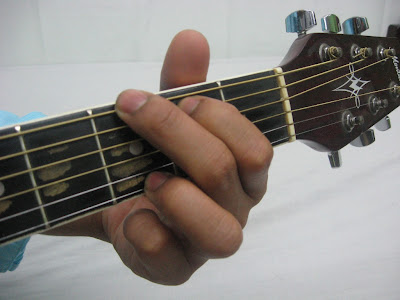A minor chord has a distinct sound from that of a major chord that can be characterized as soft and sad. Always remember that a chord that's named by a capital letter followed by a small "m" is a minor chord.
The following figures shows the fingering the chords in the D-family:
Em Chord diagram and left-hand fingering


G Chord diagram and left-hand fingering
or
Alternative Fingering for G Chord
As you may notice, none of the strings in the two chords above are marked with an X symbol which simply means that you can strike all the strings when you play the chords. Also, an alternative fingering for the G chord (2-3-4 instead of 1-2-3) can be used once your hands gains strength and more flexible. Using the 2-3-4 fingering allows you to switch to other chords fast and easily.
Now lets try playing these in a progression as shown in the image below:
The figure above shows that the second beat of each measure is divided into two strums - up and down. But this should only take one beat which means that you have to play 2 strums as quickly as you can in beat 2.
The  symbol means that you do a downward strumming and the
symbol means that you do a downward strumming and the  symbol means an upward strum toward the ceiling.
symbol means an upward strum toward the ceiling.
 symbol means that you do a downward strumming and the
symbol means that you do a downward strumming and the  symbol means an upward strum toward the ceiling.
symbol means an upward strum toward the ceiling.
If you are using your fingers to play, use the back of your fingernails to strum an upstroke whenever you see the  symbol.
symbol.
 symbol.
symbol.
The term sim. instructs you to play in the same manner for the rest of the chords which is down, down-up, down, and down pattern.




No comments:
Post a Comment